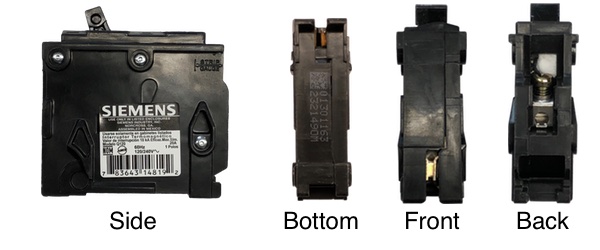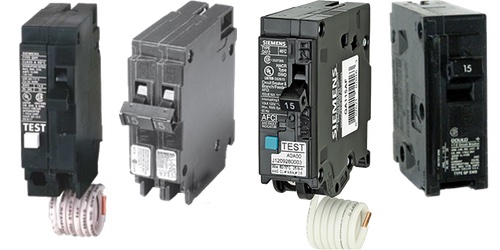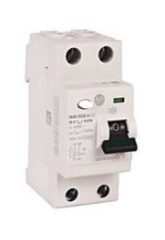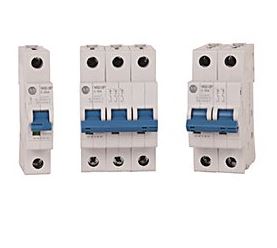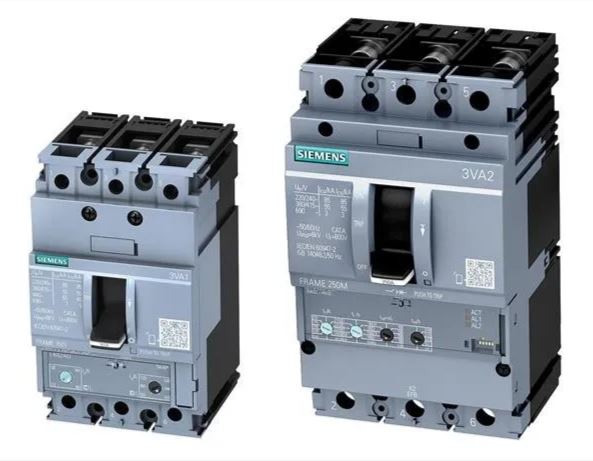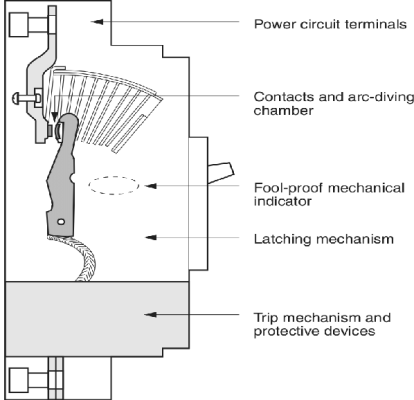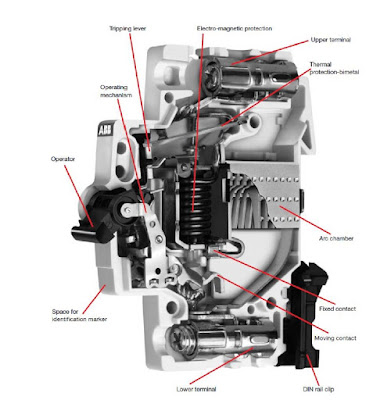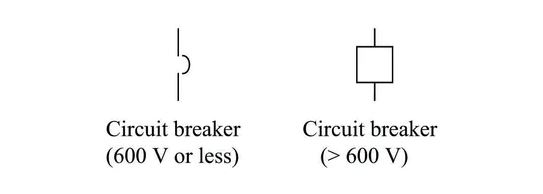Circuit Breakers
A circuit breaker is a mechanical switch that activates automatically to guard a circuit against harm brought on by shorts or overcurrent.
Upon detecting a significant current spike due to overloading or a short circuit, it automatically interrupts the circuit. This is often referred to as “tripping” or “breaking”
It can also be used as an added safety feature to manually break the circuit for maintenance reasons.
How Do Circuit Breakers Work?
Understanding basic concepts:
An electrical current passing across a circuit is measured in amperes (amps). A circuit’s voltage, often known as potential difference, is measured in volts. Even though electrons can pass through almost anything, the ease with which they do so is measured as resistance.
- Resistance is measured using a unit of measurement known as Ohms.
- Watts, which result from multiplying the total number of volts by the total number of amps, are used to measure electrical power.
A conductor, or substance that permits the flow of electrical currents, such as a copper wire, is used by the power source to push electrons out into space. The current flows in a normal cycle from the source to the load (what you are powering) and back to the source
Breakers Explained:
- A circuit breaker shuts off the power to the circuit when it exceeds its rated current limit
- Numerous factors including overloading, short circuits, voltage spikes, etc., might cause the current to exceed the breakers limit
- When a load draws a higher amount of current than the breakers rated capacity, it overloads and “trips”
Example:
When the circuit breaker lever is in the “on” position, power can readily flow from the power source, which is often the electrical panel or main, through the trip unit, contacts, and upper terminal to power the circuit’s loads.
In an overload situation, the bi-metallic strip of the thermal-magnetic trip device overheats, bends, and opens the circuit (automatically cutting off power). A short circuit causes the contacts inside the circuit breaker to separate, tripping the breaker and disconnecting power to the faulty circuit.
Common Ratings
In the home:
Household breakers used in circuits controlling outlets, lights and switches are typically rated for either 15 amps or 20 amps. To reduce damage to components and circuits caused by overload, these breakers will trip at lower than maximum rated capacity (usually 80% of max).
example: 15-amp max = 12-amp trip rating
Common Household Breakers:
Commercial and Industrial:
Unlike household breakers, Industrial and commercial applications require almost endless options and trip ratings depending on their intended use.
Some examples of common trip ratings for these applications include:
3, 6, 10, 15, 20, 25, 30, 35, 40, 45, 50, 60, 70, 80, 90, 100, 110, 125, 150, 175, 200, 225, 250, 300, 350, 400, 450, 500, 600, 700, 800, 1000, 1200, 1600, 2000, 2500, 3000, 4000 5000, and 6000 amps.
Common Commercial / Industrial Breakers:
How To Test A Circuit Breaker
Since these components are simple, they are not difficult to test. there are many ways to perform a breaker test but the two most common are a manual or metered test
Manual Testing:
Performing a manual test is simple – switch the breaker off.
If the device or component on the load side of the breaker stops functioning or turns off, the breaker is working properly.
Also worth noting: Most breakers have a “test” switch.
Pressing the test button on a breaker briefly opens the contacts inside breaking the circuit for a quick visual inspection.
Metered Testing:
With the certain safety precautions, a multimeter or voltmeter can be used to quickly determine if voltage is flowing through a circuit breaker properly.
by touching the multimeter leads to either ground or both the top and bottom terminals you will be able to check for voltage flow through the breaker.
With a voltmeter you can simply bring the tip of the meter close to the top and bottom terminals observing the visual or audible indicator that voltage is flowing through.
Parts Of A Circuit Breaker
- Frame
It protects the components on the inside and anything on the outside of the circuit breaker if a hazard occurs.
- Terminal
The terminal is a metal block with a bolt extending from the outside. Wires that transport electrical current from the power supply, through the breaker, and to the load are connected here at the terminal.
- Lever
An electrical breaker can be turned on or off using the lever (switch), which is attached to the trip unit. The lever will be in the middle when a circuit breaker trips to make it easy to see which one has to be repaired.
- Contacts
The circuit can be closed or opened by moving the contacts, which are two metal pieces. The primary panel is connected to one contact, which is coupled to the actuator mechanism.
- Mechanism Actuator
Inside the circuit breaker is a metal arm that serves as the actuator mechanism. The lever is attached to one end, and a contact is attached to the other. The actuator mechanism squeezes or pulls the contacts apart when the lever is flipped.
- Trip Unit
In the event of an overload, short circuit, or fault, a trip unit instructs the breaker when to trip automatically.
PDFs / Technicals
Circuit Breakers and Miniature Breakers
Circuit Breaker Symbols:
Safety
Many electrical hazards are avoidable.
- Always double-check that there aren’t too many components overloading a circuit
- Always check for any loose connections or old hardware.
- Circuit breakers are designed to help to keep us secure from harm or fire incidents.
Useful Resources
Continued learning..
How To Test A Motor With A Megohmmeter
Fluorescent Ballasts: What They Do and How
Electrical Resistance: How It Works
Contactors vs Relays: How Do They Work?
Brake Rectifiers and Reactors Explained
FAQ
Why does my electrical breaker keep tripping?
An electrical breaker trips as a safety measure to protect the circuit from overloading, short-circuiting, or grounding faults. Some common causes of a tripped breaker include too many appliances being used at once, a defective appliance, a damaged electrical cord, or an electrical overload.
How many outlets can be on a 20 amp circuit?
Generally, you should limit the number of outlets on a 20 amp circuit to no more than 12. Each outlet should be rated for 20 amps, and the total load on the circuit should not exceed 80% of the breaker’s capacity, which is 16 amps.
What type of breaker is used in most homes?
In most homes, the type of breaker used is a circuit breaker. This type of breaker is designed to automatically interrupt the flow of electricity when it senses an overload or short circuit.
What happens if a breaker won’t reset?
If a breaker won’t reset, it could indicate a more serious problem with the electrical system. It’s best to turn off the power to the circuit and inspect the system to identify the issue and make any necessary repairs.
Should I be worried if my breaker keeps tripping?
Yes, you should be concerned if your breaker keeps tripping, as it is a sign of an electrical problem that needs to be addressed. Tripping breakers can indicate an electrical overload, short-circuit, or other issue that could cause damage to your electrical system or even be a fire hazard.
What is the most common cause of a tripped breaker?
The most common cause of a tripped breaker is an electrical overload, which occurs when too many appliances are being used at once, or a single appliance is drawing too much power. Other common causes include a short circuit, a defective appliance, or a damaged electrical cord.
